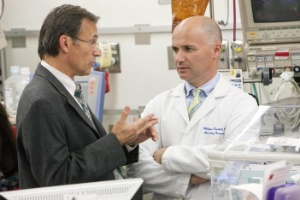The neonatologist team at the Children’s Hospital Los Angeles have investigated the use of the remote-controlled, robotic telemedicine in the neonatal intensive care unit (NICU) and have submitted a report that indicates that the system is safe to use.
 Dr. Istvan Seri and Dr. Philippe Friedlich, Center for Fetal and Neonatal Medicine at Children's Hospital Los Angeles
Dr. Istvan Seri and Dr. Philippe Friedlich, Center for Fetal and Neonatal Medicine at Children's Hospital Los Angeles
Philippe Friedlich, one of the authors of the report, is of the opinion that telemedicine provides expert care at situations where physical presence is not possible. Telemedicine proves to be very useful in attending to an emergency where the off-site neonatologist is able to get visual and auditory information about the infant’s condition. The system could also be useful in providing consultations for emergency cases by subspecialists and neonatologists who would be available 24 hours at a medical centre.
The study was conducted over 304 patient encounters, out of which 46 were premature infants and others were full-term newborns located at the level IIIa NICU. Each of the infants was evaluated by the on-site and the off-site neonatologist. The off-site neonatologist took the helpof a wireless, mobile, robotic telecommunications system to monitor the patient. The robot was equipped with a video camera, an electronic stethoscope, microphone, LCD display screen and a motorized platform, which the off-site neonatologist could control. The off-site neonatologist took the help of a computer station, which is supported by a joystick, microphone, loudspeakers and a microphone to control the robot. Through this communication path, the off-site neonatologist was able to identify and asses the patient’s condition by safely guiding the robot in the NICU. Except for a few parameters, the assessment of the on-site and the off-site neonatologists were in good agreement with each other. Istvan Seri, director of the Center of Foetal and Neonatal Medicine at the Children’s Hospital, recommended the use of the robotic telemedicine at community hospitals. The article, which was authored by Arlene Garingo, Philippe Friedlich, Istvan Seri, ShilpaPatil and Linda Tesoriero has been published in the Journal of Perinatology.